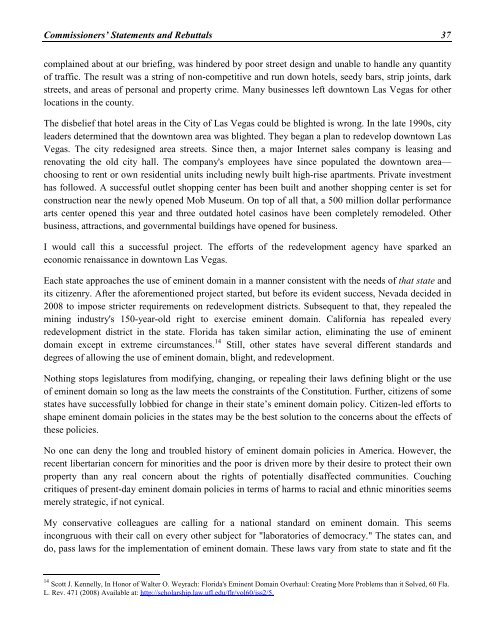You also want an ePaper? Increase the reach of your titles
YUMPU automatically turns print PDFs into web optimized ePapers that Google loves.
Commissioners’ Statements and Rebuttals 37complained about at our briefing, was hindered by poor street design and unable to handle any quantityof traffic. The result was a string of non-competitive and run down hotels, seedy bars, strip joints, darkstreets, and areas of personal and property crime. Many businesses left downtown Las Vegas for otherlocations in the county.The disbelief that hotel areas in the City of Las Vegas could be blighted is wrong. In the late 1990s, cityleaders determined that the downtown area was blighted. They began a plan to redevelop downtown LasVegas. The city redesigned area streets. Since then, a major Internet sales company is leasing andrenovating the old city hall. The company's employees have since populated the downtown area—choosing to rent or own residential units including newly built high-rise apartments. Private investmenthas followed. A successful outlet shopping center has been built and another shopping center is set forconstruction near the newly opened Mob Museum. On top of all that, a 500 million dollar performancearts center opened this year and three outdated hotel casinos have been completely remodeled. Otherbusiness, attractions, and governmental buildings have opened for business.I would call this a successful project. The efforts of the redevelopment agency have sparked aneconomic renaissance in downtown Las Vegas.Each state approaches the use of eminent domain in a manner consistent with the needs of that state andits citizenry. After the aforementioned project started, but before its evident success, Nevada decided in2008 to impose stricter requirements on redevelopment districts. Subsequent to that, they repealed themining industry's 150-year-old right to exercise eminent domain. California has repealed everyredevelopment district in the state. Florida has taken similar action, eliminating the use of eminentdomain except in extreme circumstances. 14 Still, other states have several different standards anddegrees of allowing the use of eminent domain, blight, and redevelopment.Nothing stops legislatures from modifying, changing, or repealing their laws defining blight or the useof eminent domain so long as the law meets the constraints of the Constitution. Further, citizens of somestates have successfully lobbied for change in their state’s eminent domain policy. Citizen-led efforts toshape eminent domain policies in the states may be the best solution to the concerns about the effects ofthese policies.No one can deny the long and troubled history of eminent domain policies in America. However, therecent libertarian concern for minorities and the poor is driven more by their desire to protect their ownproperty than any real concern about the rights of potentially disaffected communities. Couchingcritiques of present-day eminent domain policies in terms of harms to racial and ethnic minorities seemsmerely strategic, if not cynical.My conservative colleagues are calling for a national standard on eminent domain. This seemsincongruous with their call on every other subject for "laboratories of democracy." The states can, anddo, pass laws for the implementation of eminent domain. These laws vary from state to state and fit the14 Scott J. Kennelly, In Honor of Walter O. Weyrach: Florida's <strong>Eminent</strong> <strong>Domain</strong> Overhaul: Creating More Problems than it Solved, 60 Fla.L. Rev. 471 (2008) Available at: http://scholarship.law.ufl.edu/flr/vol60/iss2/5.


